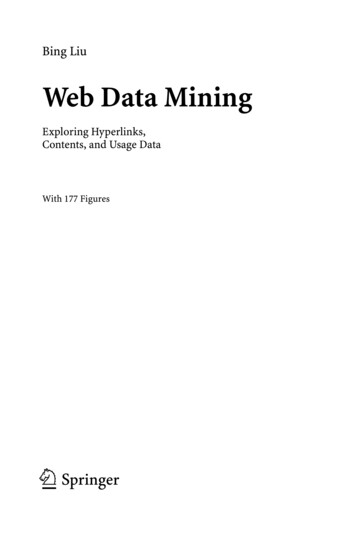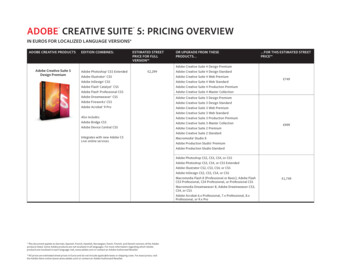
Transcription
Bing LiuWeb Data MiningExploring Hyperlinks,Contents, and Usage DataWith 177 Figures123
11 Opinion MiningIn Chap. 9, we studied structured data extraction from Web pages. Suchdata are usually records retrieved from underlying databases and displayedin Web pages following some fixed templates. The Web also contains ahuge amount of information in unstructured texts. Analyzing these texts isof great importance and perhaps even more important than extractingstructured data because of the sheer volume of valuable information of almost any imaginable types contained in them. In this chapter, we only focus on mining of opinions on the Web. The task is not only technicallychallenging because of the need for natural language processing, but alsovery useful in practice. For example, businesses always want to find publicor consumer opinions on their products and services. Potential customersalso want to know the opinions of existing users before they use a serviceor purchase a product. Moreover, opinion mining can also provide valuableinformation for placing advertisements in Web pages. If in a page peopleexpress positive opinions or sentiments on a product, it may be a good ideato place an ad of the product. However, if people express negative opinionsabout the product, it is probably not wise to place an ad of the product. Abetter idea may be to place an ad of a competitor’s product.The Web has dramatically changed the way that people express theiropinions. They can now post reviews of products at merchant sites and express their views on almost anything in Internet forums, discussion groups,blogs, etc., which are commonly called the user generated content oruser generated media. This online word-of-mouth behavior representsnew and measurable sources of information with many practical applications. Techniques are now being developed to exploit these sources to helpbusinesses and individuals gain such information effectively and easily.The first part of this chapter focuses on three mining tasks of evaluativetexts (which are documents expressing opinions):1. Sentiment classification: This task treats opinion mining as a text classification problem. It classifies an evaluative text as being positive ornegative. For example, given a product review, the system determineswhether the review expresses a positive or a negative sentiment of thereviewer. The classification is usually at the document-level. No detailsare discovered about what people liked or didn’t like.
41211 Opinion Mining1. Featured-based opinion mining and summarization: This task goesto the sentence level to discover details, i.e., what aspects of an objectthat people liked or disliked. The object could be a product, a service, atopic, an individual, an organization, etc. For example, in a product review, this task identifies product features that have been commented onby reviewers and determines whether the comments are positive ornegative. In the sentence, “the battery life of this camera is too short,”the comment is on the “battery life” and the opinion is negative. A structured summary will also be produced from the mining results.2. Comparative sentence and relation mining: Comparison is anothertype of evaluation, which directly compares one object against one ormore other similar objects. For example, the following sentence compares two cameras: “the battery life of camera A is much shorter thanthat of camera B.” We want to identify such sentences and extract comparative relations expressed in them.The second part of the chapter discusses opinion search and opinionspam. Since our focus is on opinions on the Web, opinion search is naturally relevant, and so is opinion spam. An opinion search system enablesusers to search for opinions on any object. Opinion spam refers to dishonest or malicious opinions aimed at promoting one’s own products and services, and/or at damaging the reputations of those of one’s competitors.Detecting opinion spam is a challenging problem because for opinions expressed on the Web, the true identities of their authors are often unknown.The research in opinion mining only began recently. Hence, this chaptershould be treated as statements of problems and descriptions of current research rather than a report of mature techniques for solving the problems.We expect major progresses to be made in the coming years.11.1 Sentiment ClassificationGiven a set of evaluative texts D, a sentiment classifier classifies eachdocument d D into one of the two classes, positive and negative. Positive means that d expresses a positive opinion. Negative means that d expresses a negative opinion. For example, given some reviews of a movie,the system classifies them into positive reviews and negative reviews.The main application of sentiment classification is to give a quick determination of the prevailing opinion on an object. The task is similar butalso different from classic topic-based text classification, which classifiesdocuments into predefined topic classes, e.g., politics, science, sports, etc.In topic-based classification, topic related words are important. However,
11.1 Sentiment Classification413in sentiment classification, topic-related words are unimportant. Instead,sentiment words that indicate positive or negative opinions are important,e.g., great, excellent, amazing, horrible, bad, worst, etc.The existing research in this area is mainly at the document-level, i.e.,to classify each whole document as positive or negative (in some cases, theneutral class is used as well). One can also extend such classification tothe sentence-level, i.e., to classify each sentence as expressing a positive,negative or neutral opinion. We discuss several approaches below.11.1.1 Classification Based on Sentiment PhrasesThis method performs classification based on positive and negative sentiment words and phrases contained in each evaluative text. The algorithmdescribed here is based on the work of Turney [521], which is designed toclassify customer reviews.This algorithm makes use of a natural language processing techniquecalled part-of-speech (POS) tagging. The part-of-speech of a word is alinguistic category that is defined by its syntactic or morphological behavior. Common POS categories in English grammar are: noun, verb, adjective, adverb, pronoun, preposition, conjunction and interjection. Then,there are many categories which arise from different forms of these categories. For example, a verb can be a verb in its base form, in its past tense,etc. In this book, we use the standard Penn Treebank POS Tags as shownin Table 11.1. POS tagging is the task of labeling (or tagging) each word ina sentence with its appropriate part of speech. For details on part-of-speechtagging, please refer to the report by Santorini [472]. The Penn Treebanksite is at http://www.cis.upenn.edu/ treebank/home.html.The algorithm given in [521] consists of three steps:Step 1: It extracts phrases containing adjectives or adverbs. The reason fordoing this is that research has shown that adjectives and adverbs aregood indicators of subjectivity and opinions. However, although an isolated adjective may indicate subjectivity, there may be an insufficientcontext to determine its semantic (or opinion) orientation. For example, the adjective “unpredictable” may have a negative orientation in anautomotive review, in such a phrase as “unpredictable steering”, but itcould have a positive orientation in a movie review, in a phrase such as“unpredictable plot”. Therefore, the algorithm extracts two consecutivewords, where one member of the pair is an adjective/adverb and theother is a context word.Two consecutive words are extracted if their POS tags conform to anyof the patterns in Table 11.2. For example, the pattern in line 2 means
414.11 Opinion MiningTable 11.1. Penn Treebank part-of-speech tags (excluding punctuation)TagCCCDDTEXFWINTagPRP RBRBRRBSRPSYMDescriptionPossessive pronounAdverbAdverb, comparativeAdverb, ionCoordinating conjunctionCardinal numberDeterminerExistential thereForeign wordPreposition or subordinating conjunctionAdjectiveAdjective, comparativeAdjective, superlativeList item markerModalNoun, singular or massNoun, pluralTOUHVBVBDVBGVBNVBPNNPNNPSPDTPOSPRPProper noun, singularProper noun, pluralPredeterminerPossessive endingPersonal pronounVBZWDTWPWP WRBtoInterjectionVerb, base formVerb, past tenseVerb, gerund or present participleVerb, past participleVerb, non-3rd person singular presentVerb, 3rd person singular presentWh-determinerWh-pronounPossessive wh-pronounWh-adverbthat two consecutive words are extracted if the first word is an adverband the second word is an adjective, but the third word (which is not extracted) cannot be a noun. NNP and NNPS are avoided so that the namesof the objects in the review cannot influence the classification.Table 11.2. Patterns of tags for extracting two-word phrases from reviews1.2.3.4.5.First wordSecond wordJJRB, RBR, or RBSJJNN or NNSRB, RBR, or RBSNN or NNSJJJJJJVB, VBD, VBN, or VBGThird word(Not Extracted)anythingnot NN nor NNSnot NN nor NNSnot NN nor NNSanythingExample 1: In the sentence “this camera produces beautiful pictures”,“beautiful pictures” will be extracted as it satisfies the first pattern.ɼStep 2: It estimates the semantic orientation of the extracted phrases usingthe pointwise mutual information measure given in Equation 1:
11.1 Sentiment Classification§ Pr(term1 term2 ) · .PMI (term1 , term2 ) log 2 Pr(term1 ) Pr(term2 ) ¹415(1)Here, Pr(term1 term2) is the co-occurrence probability of term1 andterm2, and Pr(term1)Pr(term2) gives the probability that the two terms cooccur if they are statistically independent. The ratio between Pr(term1 term2) and Pr(term1)Pr(term2) is thus a measure of the degree of statistical dependence between them. The log of this ratio is the amount of information that we acquire about the presence of one of the words whenwe observe the other.The semantic/opinion orientation (SO) of a phrase is computed basedon its association with the positive reference word “excellent” and its association with the negative reference word “poor”:SO(phrase) PMI(phrase, “excellent”) PMI(phrase, “poor”).(2)The probabilities are calculated by issuing queries to a search engine andcollecting the number of hits. For each search query, a search engineusually gives the number of relevant documents to the query, which isthe number of hits. Thus, by searching the two terms together and separately, we can estimate the probabilities in Equation 1. Turney [521]used the AltaVista search engine because it has a NEAR operator, whichconstrains the search to documents that contain the words within tenwords of one another, in either order. Let hits(query) be the number ofhits returned. Equation 2 can be rewritten as:SO( phrase)§ hits (phrase NEAR " excellent") hits (" poor" ) · .log 2 hits (phrase NEAR " poor" )hits (" excellent") ¹(3)To avoid division by zero, 0.01 is added to the hits.Step 3: Given a review, the algorithm computes the average SO of allphrases in the review, and classifies the review as recommended if theaverage SO is positive, not recommended otherwise.Final classification accuracies on reviews from various domains rangefrom 84% for automobile reviews to 66% for movie reviews.11.1.2 Classification Using Text Classification MethodsThe simplest approach to sentiment classification is to treat the problem asa topic-based text classification problem. Then, any text classification algorithm can be employed, e.g., naïve Bayesian, SVM, kNN, etc.
41611 Opinion MiningThe approach was experimented by Pang et al. [428] using movie reviews of two classes, positive and negative. It was shown that using a unigram (a bag of individual words) in classification performed well using either naïve Bayesian or SVM. Test results using 700 positive reviews and700 negative reviews showed that these two classification algorithmsachieved 81% and 82.9% accuracy respectively with 3-fold cross validation. However, neutral reviews were not used in this work, which made theproblem easier. No stemming or stopword removal was applied.11.1.3 Classification Using a Score FunctionA custom score function for review sentiment classification was given byDave et al. [122]. The algorithm consists of two steps:Step 1: It scores each term in the training set using the following equation,score(ti )Pr(ti C ) Pr(ti C ' ),Pr(ti C ) Pr(ti C ' )(4)where ti is a term and C is a class and Cc is its complement, i.e., not C,and Pr(ti C) is the conditional probability of term ti in class C. It is computed by taking the number of times that a term ti occurs in class C reviews and dividing it by the total number of terms in the reviews of classC. A term’s score is thus a measure of bias towards either class rangingfrom 1 and 1.Step 2: To classify a new document di t1 tn, the algorithm sums up thescores of all terms and uses the sign of the total to determine the class.That is, it uses the following equation for classification, C eval (d i ) ! 0class (d i ) C ' otherwise,(5)whereeval (d i ) score(tjj).(6)Experiments were conducted based on a large number of reviews (morethan 13000) of seven types of products. The results showed that the bigrams (consecutive two words) and trigrams (consecutive three words) asterms gave (similar) best accuracies (84.6% 88.3%), on two different review data sets. No stemming or stopword removal was applied.In this paper, the authors experimented with many alternative classification techniques, e.g., naïve Bayesian, SVM, and several algorithms based
11.2 Feature-Based Opinion Mining and Summarization417on other score functions. They also tried some word substitution strategiesto improve generalization, e.g.,x replace product names with a token (“ productname”);x replace rare words with a token (“ unique”);x replace category-specific words with a token (“ producttypeword”);x replace numeric tokens with NUMBER.Some linguistic modifications using WordNet, stemming, negation, andcollocation were tested too. However, they were not helpful, and usuallydegraded the classification accuracy.In summary, the main advantage of document level sentiment classification is that it provides a prevailing opinion on an object, topic or event.The main shortcomings of the document-level classification are:x It does not give details on what people liked or disliked. In a typicalevaluative text such as a review, the author usually writes specific aspects of an object that he/she likes or dislikes. The ability to extract suchdetails is useful in practice.x It is not easily applicable to non-reviews, e.g., forum and blog postings,because although their main focus may not be evaluation or reviewingof a product, they may still contain a few opinion sentences. In suchcases, we need to identify and extract opinion sentences.There are several variations of the algorithms discussed in this section(see Bibliographic Notes). Apart from these learning based methods, thereare also manual approaches for specific applications. For example, Tong[517] reported a system that generates sentiment timelines. The systemtracks online discussions about movies and displays a plot of the numberof positive sentiment and negative sentiment messages (Y-axis) over time(X-axis). Messages are classified by matching specific phrases that indicatesentiments of the author towards the movie (e.g., “great acting”, “wonderful visuals”, “uneven editing”, “highly recommend it”, and “it sucks”). Thephrases were manually compiled and tagged as indicating positive or negative sentiments to form a lexicon. The lexicon is specific to the domain(e.g., movies) and must be built anew for each new domain.11.2Feature-Based Opinion Mining and SummarizationAlthough studying evaluative texts at the document level is useful in manycases, it leaves much to be desired. A positive evaluative text on a particular object does not mean that the author has positive opinions on every aspect of the object. Likewise, a negative evaluative text does not mean that
41811 Opinion Miningthe author dislikes everything about the object. For example, in a productreview, the reviewer usually writes both positive and negative aspects ofthe product, although the general sentiment on the product could be positive or negative. To obtain such detailed aspects, we need to go to the sentence level. Two tasks are apparent [245]:1. Identifying and extracting features of the product that the reviewershave expressed their opinions on, called product features. For instance,in the sentence “the picture quality of this camera is amazing,” the product feature is “picture quality”.2. Determining whether the opinions on the features are positive, negativeor neutral. In the above sentence, the opinion on the feature “picturequality” is positive.11.2.1 Problem DefinitionIn general, the opinions can be expressed on anything, e.g., a product, anindividual, an organization, an event, a topic, etc. We use the general term“object” to denote the entity that has been commented on. The object has aset of components (or parts) and also a set of attributes (or properties).Thus the object can be hierarchically decomposed according to the part-ofrelationship, i.e., each component may also have its sub-components andso on. For example, a product (e.g., a car, a digital camera) can have different components, an event can have sub-events, a topic can have subtopics, etc. Formally, we have the following definition:Definition (object): An object O is an entity which can be a product, person, event, organization, or topic. It is associated with a pair, O: (T, A),where T is a hierarchy or taxonomy of components (or parts), subcomponents, and so on, and A is a set of attributes of O. Each component has its own set of sub-components and attributes.Example 2: A particular brand of digital camera is an object. It has a set ofcomponents, e.g., lens, battery, view-finder, etc., and also a set of attributes, e.g., picture quality, size, weight, etc. The battery component also hasits set of attributes, e.g., battery life, battery size, battery weight, etc.ɼEssentially, an object is represented as a tree. The root is the object itself. Each non-root node is a component or sub-component of the object.Each link represents a part-of relationship. Each node is also associatedwith a set of attributes. An opinion can be expressed on any node and anyattribute of the node.
11.2 Feature-Based Opinion Mining and Summarization419Example 3: Following Example 2, one can express an opinion on thecamera (the root node), e.g., “I do not like this camera”, or on one of its attributes, e.g., “the picture quality of this camera is poor”. Likewise, one canalso express an opinion on one of the camera’s components, e.g., “the battery of this camera is bad”, or an opinion on the attribute of the component, “the battery life of this camera is too short.”ɼTo simplify our discussion, we use the word “features” to representboth components and attributes, which allows us to omit the hierarchy. Using features for products is also quite common in practice. For an ordinaryuser, it is probably too complex to use a hierarchical representation ofproduct features and opinions. We note that in this framework the objectitself is also treated as a feature.Let the evaluative text (e.g., a product review) be r. In the most generalcase, r consists of a sequence of sentences r s1, s2, , sm².Definition (explicit and implicit feature): If a feature f appears in evaluative text r, it is called an explicit feature in r. If f does not appear in rbut is implied, it is called an implicit feature in r.Example 4: “battery life” in the following sentence is an explicit feature:“The battery life of this camera is too short”.“Size” is an implicit feature in the following sentence as it does not appearin the sentence but it is implied:“This camera is too large”.Definition (opinion passage on a feature): The opinion passage on feature f of an object evaluated in r is a group of consecutive sentences in rthat expresses a positive or negative opinion on f.It is common that a sequence of sentences (at least one) in an evaluativetext together expresses an opinion on an object or a feature of the object.Also, it is possible that a single sentence expresses opinions on more thanone feature:“The picture quality is good, but the battery life is short”.Most current research focuses on sentences, i.e., each passage consistingof a single sentence. Thus, in our subsequent discussion, we use sentencesand passages interchangeably.Definition (explicit and implicit opinion): An explicit opinion on featuref is a subjective sentence that directly expresses a positive or negativeopinion. An implicit opinion on feature f is an objective sentence thatimplies a positive or negative opinion.
42011 Opinion MiningExample 5: The following sentence expresses an explicit positive opinion:“The picture quality of this camera is amazing.”The following sentence expresses an implicit negative opinion:“The earphone broke in two days.”Although this sentence states an objective fact (assume it is true), it implicɼitly expresses a negative opinion on the earphone.Definition (opinion holder): The holder of a particular opinion is a person or an organization that holds the opinion.In the case of product reviews, forum postings and blogs, opinion holdersare usually the authors of the postings, although occasionally some authorscite or repeat the opinions of others. Opinion holders are more important innews articles because they often explicitly state the person or organizationthat holds a particular view. For example, the opinion holder in the sentence “John expressed his disagreement on the treaty” is “John”.We now put things together to define a model of an object and a set ofopinions on the object. An object is represented with a finite set of features, F {f1, f2, , fn}. Each feature fi in F can be expressed with a finiteset of words or phrases Wi, which are synonyms. That is, we have a set ofcorresponding synonym sets W {W1, W2, , Wn} for the n features.Since each feature fi in F has a name (denoted by fi), then fi Wi. Each author or opinion holder j comments on a subset of the features Sj F. Foreach feature fk Sj that opinion holder j comments on, he/she chooses aword or phrase from Wk to describe the feature, and then expresses a positive or negative opinion on it.This simple model covers most but not all cases. For example, it doesnot cover the situation described in the following sentence: “the viewfinder and the lens of this camera are too close”, which expresses a negative opinion on the distance of the two components. We will follow thissimplified model in the rest of this chapter.This model introduces three main practical problems. Given a collectionof evaluative texts D as input, we have:Problem 1: Both F and W are unknown. Then, in opinion mining, we needto perform three tasks:Task 1: Identifying and extracting object features that have been commented on in each evaluative text d D.Task 2: Determining whether the opinions on the features are positive,negative or neutral.
11.2 Feature-Based Opinion Mining and Summarization421Task 3: Grouping synonyms of features, as different people may use different words or phrases to express the same feature.Problem 2: F is known but W is unknown. This is similar to Problem 1,but slightly easier. All the three tasks for Problem 1 still need to be performed, but Task 3 becomes the problem of matching discovered features with the set of given features F.Problem 3: W is known (then F is also known). We only need to performTask 2 above, namely, determining whether the opinions on the knownfeatures are positive, negative or neutral after all the sentences that contain them are extracted (which is simple).Clearly, the first problem is the most difficult to solve. Problem 2 isslightly easier. Problem 3 is the easiest, but still realistic.Example 6: A cellular phone company wants to mine customer reviews ona few models of its phones. It is quite realistic to produce the feature set Fthat the company is interested in and also the set of synonyms of each feature (although the set might not be complete). Then there is no need to perɼform Tasks 1 and 3 (which are very challenging problems).Output: The final output for each evaluative text d is a set of pairs. Eachpair is denoted by (f, SO), where f is a feature and SO is the semantic oropinion orientation (positive or negative) expressed in d on feature f. Weignore neutral opinions in the output as they are not usually useful.Note that this model does not consider the strength of each opinion, i.e.,whether the opinion is strongly negative (or positive) or weakly negative(or positive), but it can be added easily (see [548] for a related work).There are many ways to use the results. A simple way is to produce afeature-based summary of opinions on the object. We use an example toillustrate what that means.Example 7: Assume we summarize the reviews of a particular digitalcamera, digital camera 1. The summary looks like that in Fig. 11.1.In Fig. 11.1, “picture quality” and (camera) “size” are the product features. There are 123 reviews that express positive opinions about the picture quality, and only 6 that express negative opinions. The individual review sentences link points to the specific sentences and/or the wholereviews that give positive or negative comments about the feature.With such a summary, the user can easily see how the existing customers feel about the digital camera. If he/she is very interested in a particularfeature, he/she can drill down by following the individual review sentences link to see why existing customers like it and/or what they are not
42211 Opinion MiningDigital camera 1:Feature: picture qualityPositive: 123 individual review sentences Negative: 6 individual review sentences Feature: sizePositive: 82 individual review sentences Negative: 10 individual review sentences Fig. 11.1. An example of a feature-based summary of opinionssatisfied with. The summary can also be visualized using a bar chart. Figure 11.2(A) shows the feature-based opinion summary of a digital camera.In the figure, the bars above the X-axis in the middle show the percentages of positive opinions on various features (given at the top), and thebars below the X-axis show the percentages of negative opinions on thesame ghtDigital Camera 1(A) Feature-based summary of opinions on a digital camerapositivenegativePictureBatteryDigital Camera 1ZoomSizeWeightDigital Camera 2(B) Opinion comparison of two digital camerasFig. 11.2. Visualization of feature-based opinion summary and comparison
11.2 Feature-Based Opinion Mining and Summarization423Comparing the opinion summaries of a few competing products is evenmore interesting. Figure 11.2(B) shows a visual comparison of consumeropinions on two competing digital cameras. We can clearly see how consumers view different features of each product. Digital camera 1 is clearlysuperior to digital camera 2. Specifically, most customers have negativeopinions about the picture quality, battery and zoom of digital camera 2.However, on the same three features, customers are mostly positive aboutdigital camera 1. Regarding size and weight, customers have similar opinions on both cameras. Thus, the visualization enables users to clearly seehow the cameras compare with each other along each feature dimension. ɼBelow, we discuss four other important issues.Separation of Opinions on the Object itself and its Features: It is oftenuseful to separate opinions on the object itself and opinions on the featuresof the object. The opinion on the object itself reflects the general sentimentof the author (or the opinion holder) on the object, which is what sentimentclassification tries to discover at the document level.Granularity of Analysis: Let us go back to the general representation ofan object with a component tree and each component with a set of attributes. We can study opinions at any level.At level 1: We identify opinions on the object itself and its attributes.At level 2: We identify opinions on the major components of the object,and also opinions on the attributes of the components.At other levels, similar tasks can be performed. However, in practice,analysis at level 1 and level 2 are usually sufficient.Example 8: Given the following review of a camera (the object),“I like this camera. Its picture quality is amazing. However, the battery life is a little short”,in the first sentence, the positive opinion is at level 1, i.e., a positive opinion on the camera itself. The positive opinion on the picture quality in thesecond sentence is also at level 1 as “picture quality” is an attribute of thecamera. The third sentence expresses a negative opinion on an attribute ofthe battery (at level 2), which is a component of the camera.ɼOpinion Holder Identification: In some applications, it is useful to identify and extract opinion holders, i.e., persons or organizations that have expressed certain opinions. As we mentioned earlier, opinion holders aremore useful for news articles and other types of formal documents, inwhich the person or organization that expressed an opinion is usuallystated in the text explicitly. However, such holders need to be identified by
42411 Opinion Miningthe system. In the case of the user-generated content on the Web, the opinion holders are often the authors of discussion posts, bloggers, or reviewers, whose login ids are often known although their true identities in thereal-world may be unknown. We will not discuss opinion holders in thechapter further due to our focus on the user-generated content on the Web.Interested r
The first part of this chapter focuses on three mining tasks of evaluative texts (which are documents expressing opinions): 1. Sentiment classification: This task treats opinion mining as a text clas-sification problem. It classifies an evaluative text as being positive or negative. For example, given a product review, the system determines










